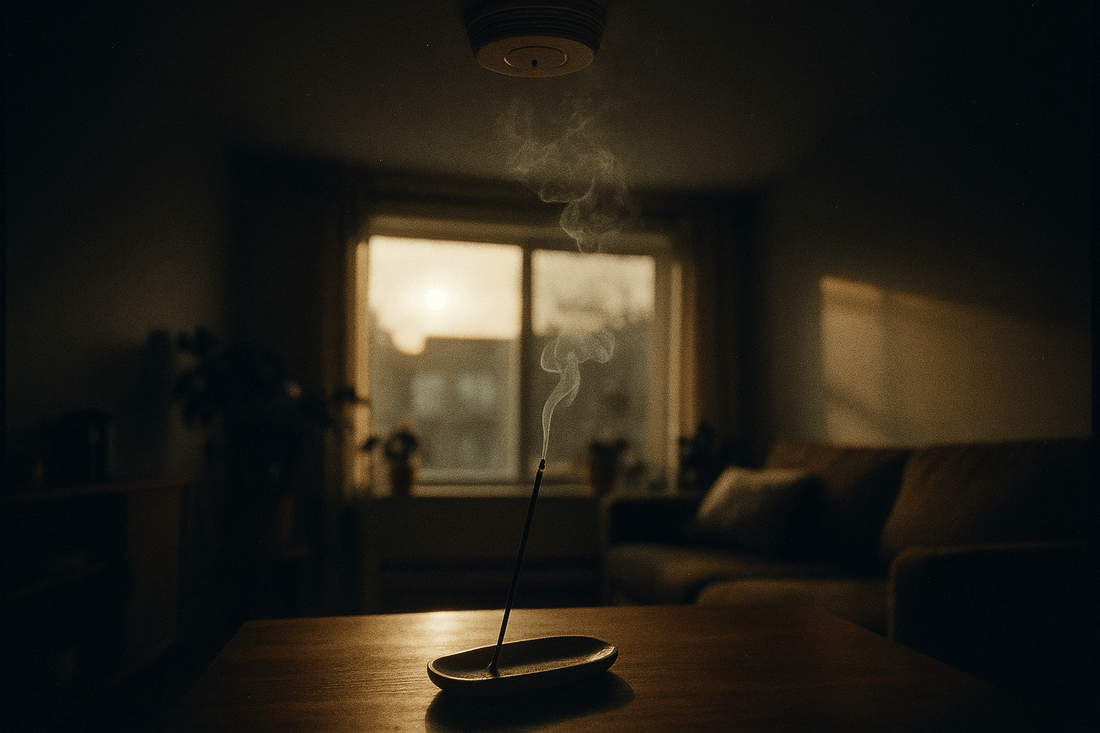
Can Burning Incense Set Off a Smoke Alarm?
Here’s nothing quite like lighting incense to create a calm, grounded space—whether you’re meditating, relaxing after work, or simply adding warmth to your home’s atmosphere. But before you buy incense or strike a match, you might wonder: Will incense set off my smoke alarm?
The short answer: burning incense is unlikely to trigger a smoke detector in your daily use. Whether or not incense triggers your smoke detector depends on the type of alarm, the space you’re burning it in, and how much smoke the incense produces.
Let’s break it down.
How Smoke Alarms Work
To understand the risk, we need to know how smoke alarms actually work. Ionisation Smoke Alarms are better at detecting fast-flaming fires with smaller smoke particles (e.g., burning paper or grease). They are more sensitive to fine particles, including those produced by incense. Photoelectric Smoke Alarms detect larger smoke particles from slow, smouldering fires (like upholstery or wood). They are generally less likely to be triggered by incense, unless it produces a lot of smoke or is burned very close to the sensor.
Does Incense Produce Enough Smoke?
Not all incense creates the same amount of smoke. Mass-produced incense often contains synthetic binders or charcoal that generate thicker, heavier smoke. In contrast, high-quality, natural incense—such as Japanese-style coreless sticks or Tibetan blends—tends to burn cleaner and with less visible smoke. After many tests, we found that burning one or two SomaScents incense sticks in a well-ventilated room is unlikely to trigger a smoke alarm in most cases. However, burning multiple sticks at once or placing them too close to a ceiling-mounted detector increases the chance of a false alarm, especially in small or enclosed spaces.
Other Factors That Matter
The setup of your space also plays a big role. Rooms with poor airflow, closed windows, or stagnant air can allow smoke to build up and drift upward, setting off the alarm. Air currents from fans or air conditioning can carry incense smoke toward a detector even if it's not directly underneath. Ideally, incense should be burned in a well-ventilated area away from smoke detectors, windows should be cracked open, and only a single stick or cone should be used at a time to minimise the risk.
How to Burn Incense Without Setting Off Your Smoke Alarm?
To enjoy incense without setting off your smoke alarm, the key is smoke control through smart burning habits.
First and foremost, always burn incense in a well-ventilated room. Open a window or use a fan to ensure smoke can circulate and dissipate quickly rather than gathering near the ceiling. Good airflow not only reduces the chance of false alarms but also enhances your incense experience by keeping the aroma light and pleasant rather than overwhelming.
Placement matters, too. Avoid burning incense directly under or near a smoke detector. Even a small plume of smoke drifting upward over time can accumulate near the sensor and cause it to activate. Ideally, set your incense on a low, heat-safe surface near a window, in a corner of the room, or in a place where airflow moves smoke away from detectors. If possible, test different areas of your space to identify the safest spots.
When selecting incense, choose natural, low-smoke options made without synthetic binders or chemical additives. Japanese-style coreless sticks or Tibetan incense blends tend to produce much less smoke compared to commercial charcoal-based cones or thick bamboo-core sticks. Try to burn only one stick or cone at a time, especially in smaller spaces. Burning multiple incense items increases particulate concentration, making it more likely to trip a smoke detector—particularly if your alarm uses an ionisation sensor, which is more sensitive to fine particles.
Finally, be mindful of your surroundings. If you're using incense regularly, consider installing an air purifier to reduce lingering particles in the room. Always monitor the smoke level—if it looks dense or swirls near the ceiling for too long, that’s a sign to improve airflow. And while it might be tempting, never disable or cover your smoke alarm to accommodate incense. With thoughtful placement, ventilation, and the right incense, you can enjoy your rituals without triggering alarms or compromising safety.
Final Thoughts
Incense can sometimes set off a smoke alarm—but it doesn’t have to. With the right incense, good ventilation, and smart placement, you can safely enjoy your ritual without any loud interruptions.
As always, pay attention to how your space reacts, like we explained in our last blog about pets, and when in doubt, start small. A little mindfulness goes a long way when mixing smoke and safety.
